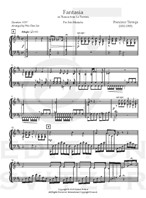
Fantasia on Themes from La Traviata
Composer: Francisco Tárrega
Instrument: Marimba
Level: Intermediate
Published: 2015
Price: €16.00
Item details
-
Description +
-
Arranged by Wei-Chen Lin
Duration: 7 min.
“Fantasia” was written by Spanish guitarist and composer Franceso Tárrega (1852-1909) in 1888, and incorporates some of the most well-known melodies from Giacomo Verdi’s great opera La Traviata, rendered in romantic musical language. Fantasia includes five sections, each exploring a different aspect of the aesthetics of guitar music. The original version for guitar is transcribed here for marimba. For me, the acoustics of the piece is uniquely suited for marimba, and the new arrangement requires advanced technique to showcase the character of the instrument.
-
-
Instrumentation +
-
Marimba (5-octave)
-
-
About the composer +
-
Francisco Tárrega was an important Spanish composer whose music and style of guitar playing became strongly influential in the twentieth century. He was central to reviving the guitar as a solo instrument in recital and concerts. Among his most popular compositions are Recuerdos de la Alhambra and Danza mora. He wrote nearly eighty original works for the guitar and over a hundred transcriptions, mostly of piano pieces by Chopin, Beethoven, and others.
Francisco Tárrega was born on November 21, 1852, in Villareal, Castellon, Spain. An accident in his early childhood permanently impaired his eyesight. He was taught his first lessons on guitar by Eugeni Ruiz, ironically a blind musician. In 1862, concert guitarist Julian Arcas, on tour in Castellon, heard young Francisco play and advised Tárrega's father to allow Francisco to come to Barcelona for study with him. Tárrega's father agreed, but insisted that he take piano lessons as well. His father was well aware that the guitar, as a solo vehicle, was in decline, coming increasingly to be viewed as an instrument to accompany singers, while the piano was all the rage throughout Europe.
By his early teens, Tárrega had become proficient on both instruments. For a time, he played with other musicians at local engagements to earn money, but eventually he returned home. In 1874 he enrolled at the Madrid Conservatory where he would study composition under Arrieta. He had brought along with him a recently-purchased guitar, made in Seville by Antonio Torres. Its superior sonic qualities inspired him both in his playing and in his view of the instrument's compositional potential. When Arrieta heard his student Tárrega in a guitar concert, he convinced him to focus on guitar and abandon ideas of a career involving the piano.
In about 1876, Tárrega began teaching and giving regular guitar concerts. He typically received much acclaim for his playing and began traveling to other areas of Spain to perform. By this time he was composing his first works for guitar. In 1880, he met his future wife, Maria Rizo, when he was giving a concert in Novelda. That same year he went on tour to Lyon, Paris, and London, now playing his own works in addition to those of other composers. In 1881, he and Maria were married in Novelda. He soon began transcribing piano works of Beethoven, Chopin, Mendelssohn, and others to enlarge his guitar repertory, and, no doubt, to make use of his considerable knowledge of keyboard music. Tárrega and his wife moved to Madrid, but after the death of an infant daughter, Maria Josefa, they settled permanently in Barcelona in 1885.
On a concert tour in Valencia shortly afterward, Tárrega met a wealthy widow, Conxa Martinez, who became a valuable patron to him. She allowed him and his family use of a house in Barcelona, where he would write the bulk of his most popular works, including Recuerdos de la Alhambra. From the latter 1880s up to 1903, Tárrega continued composing, but limited his concerts to Spain. In about 1902, he cut his fingernails and created a sound that would become typical of those guitarists associated with his school. The following year he launched a tour of Italy, giving highly successful concerts in Rome, Naples, and Milan.
In January 1906, he was afflicted with paralysis on his right side, and though he would eventually return to the concert stage, he never completely recovered. He finished his last work, Oremus, on December 2, 1909. He died 13 days later.
-
-
Reviews +
-
Review (Percussive Notes, July 2016)
“Fantasia” is simply gorgeous! Written for guitar in 1888 by Francisco Tárrega and transcribed by Wei-Chen Lin for marimba in 2015, this piece contains some of the most well-known melodies from Giacomo Verdi’s opera La Traviata. The opera selections in “Fantasia” were originally chosen to highlight the range of tonal and musical characteristics of the guitar, and this transcription beautifully demonstrates that the marimba has a similar versatility.
The piece utilizes the entire 5-octave instrument and requires playing that ranges from reflective and sensitive to transparent and virtuosic. In addition to the musical challenges inherent in connecting numerous melodies and varied styles, the piece poses some technical challenges, including occasional large intervals in the left hand, glissandi utilizing multiple notes, and single-handed trills. The payoff, however, of playing these beautiful melodies on the marimba is well worth overcoming the challenges!—Julie Licata
-
-
Credits +
-
Front Cover graphics and layout: Gaia Gomes
Engraving: Johan Svitzer
Printed in Copenhagen, Denmark
Copyright © Edition SVITZER
www.editionsvitzer.com
-




